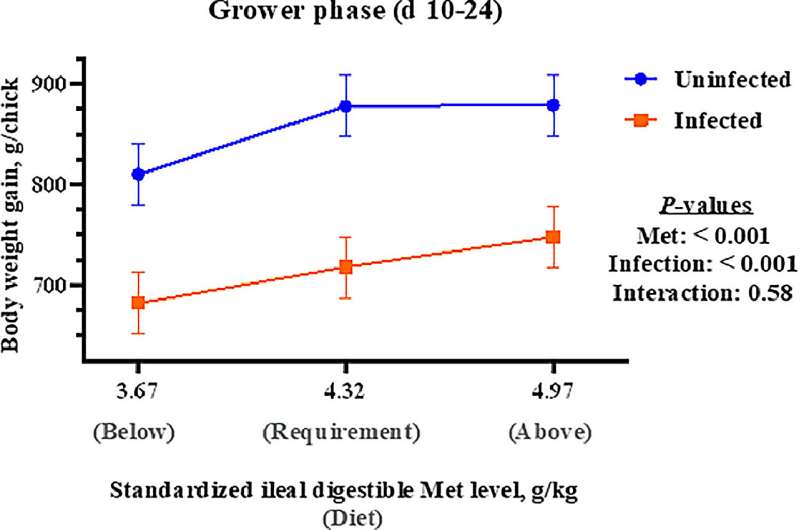This article has been reviewed according to Science X's editorial process and policies. Editors have highlighted the following attributes while ensuring the content's credibility:
fact-checked
trusted source
proofread
Supporting disease-challenged broiler chickens through nutrition

When broiler chickens are busy fighting the parasitic infection coccidiosis, they can't absorb nutrients efficiently or put energy toward growth. With consumer sentiment pitted against antimicrobials and other drugs, producers still have some options to ensure optimal growth during inevitable outbreaks. New research from the University of Illinois Urbana-Champaign suggests diet changes might help.
"Vaccines and anticoccidials are the traditional ways to prevent this disease. Nutrition can't replace all of the pharmaceuticals, but it can be supportive in providing care," said senior study author Ryan Dilger, professor in the Department of Animal Sciences, part of the College of Agricultural, Consumer and Environmental Sciences (ACES) at U. of I.
Standard poultry diets have been carefully formulated to provide for the nutritional requirements of healthy birds, but diets have never been holistically optimized for disease-challenged broilers. Dilger and doctoral student Julianna Jespersen set out to fill that gap.
"Using nutrition to support healthy poultry has been a hot topic for 50-plus years. The novelty in our approach is to look at all the major nutrients simultaneously rather than looking at them individually," Dilger said. "That's information producers can use."
In two studies, both published in Poultry Science, the research team induced coccidiosis and then altered the diet to understand the roles of various ingredients. In the first study, the team adjusted the starch, oil, and amino acid content of the classic broiler diet and monitored body weight gain and feed conversion ratio.
"If you visualize a triangle, the three points represent diets with the highest starch, oil, and amino acid content," Jespersen explained. "We used varying proportions of those three ingredients to mix 10 experimental diets, one being a control diet with an equal proportion of each ingredient."
The optimal diet mix—the diet leading to the highest body weight gain in coccidiosis-challenged birds—consisted of 35.8% starch, 8.9% oil, and 101.3% recommended amino acids relative to the control diet.
The researchers acknowledge that 9% oil inclusion is well above practical levels for the industry.
"That level of oil is going to be hard for producers to fathom. But previous research from our lab has shown this parasite reduces lipid absorption in the gastrointestinal tract, so the birds can't get as much energy or lipid components out of the diet," Dilger said. "We think that's why we found optimal results at 9%. Producers might look at that and laugh, but the bird is telling us why it should be that high for optimizing outcomes in disease-challenged birds."
Jespersen says although it may not be feasible to include oil at 9%, the results show that increasing oil to any level above the usual 1% should be beneficial.
A second study looked specifically at optimal levels of methionine for coccidiosis-challenged broilers. As the first limiting amino acid, methionine levels dictate the overall growth of the bird.
"Unless methionine is supplied at adequate levels, it doesn't matter how much of the other amino acids are in the diet," Jespersen explained.
Again, methionine inclusion levels have been determined for healthy chickens, but little was known about how much of the amino acid is needed in disease-challenged birds. The research team tested a diet with methionine levels 15% below, equivalent to, and 15% above that of a standard diet for healthy birds.
The data showed that bumping methionine up from 15% below to the equivalent amount was beneficial and suggested that more was even better. However, the results were statistically inconclusive.
"We did not actually determine what the methionine requirement was for infected birds in this experiment, but we found evidence that the methionine requirement does increase during a coccidiosis infection," Jespersen said. "Knowing that most broilers are going to be exposed to this infection during their growth cycle, we're recommending that we bump up methionine. We still need to do more research to determine the exact level."
Dilger says coccidiosis is a fact of life for broiler production. Birds walk on the ground and will inevitably ingest parasites, which start to propagate in their intestines.
"One parasite becomes two, becomes four, and then they excrete them out, and other birds pick them up. They're always cycling in this way," he said. "We're hoping producers will use what we've learned here about nutrition to help broilers combat infection and keep growing."
More information: J.C. Jespersen et al, Defining optimal dietary starch, oil, and amino acid inclusion levels for broilers experiencing a coccidiosis challenge, Poultry Science (2023). DOI: 10.1016/j.psj.2023.103335
J.C. Jespersen et al, Effects of a coccidiosis challenge on dietary methionine recommendations in broilers, Poultry Science (2024). DOI: 10.1016/j.psj.2024.103502
Provided by University of Illinois at Urbana-Champaign




















